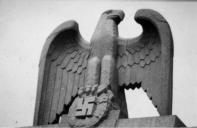§§ Hitler -- more popular by the day, by the hour. As artists go, his posthumous success has been phenomenal, although he destroyed more than he created. His political legend continues to grow, while his artistic expression is either forgotten or dismissed as amateur. In the 1930s, as his paintings were forged and bootlegged, he cynically dispatched agents to hunt down the copies and copyists. Is he another artist whose own story is far more interesting than any of the work he created, a homicidal lunatic who parlayed a failed career as a painter of sentimental Austrian landscapes into the leader of German defeat-outrage and the death-cult of lebensraum? He was a master of manipulation and revenge, but was he ever any good as an artist? And what was his "art" exactly: was it all show-biz uniforms and searchlight tattoos, radio monologues and neo-Roman salutes?
He always thought big, and that big statements were the best, so he wanted to be an architect. Speaking about a folio of a 125 drawings by Hitler that he had in his possession, Albert Speer said, "They were casually tossed off but accurate in perspective; he drew outlines, cross-sections, and renderings to scale. An architect could not have done better." [Inside the Third Reich, p.143] Albert Speer was Hitler's architect, a sort of benign doppelganger Hitler used to carry out his Wagnerian fantasies for the reconstruction of the new Germany as a mythic 1,000 year Reich. Speer certainly knew what he was talking about. He and Hitler designed their modernist, neo-classical public buildings according to an aesthetic they called "ruin value", that is, as a civilization and its culture is defined by the supernatural expression of its future ruined monuments, all building design should anticipate its archaeological fate. While this "death as beauty" concept might seem radical, it is just the natural extension of Greco-Roman classicism and German Romanticism, which always loved madmen, ruined castles and forgotten tombs. A famous example of this would be Caspar David Friedrich's painting The Cloister Graveyard in the Snow (1810), which was destroyed by a bombing raid in 1945. The irony is obvious, of course, although Friedrich painted a number of variations of this setting and theme. [Dolmen in the Snow, Giant Grave by the Sea, The Ruins of Eldena, et. al.]

Hitler probably never read Madame de Stael's influential book De l'Allemagne (Germany) (1810), which drew a distinction between the "imitativeness" of classicism and the "spirituality" of romanticism. Hitler's failure as a painter and his success as a proto-architect is mirrored in this distinction. He was indifferent to religion and completely imitative in terms of architecture, although his obsessive knowledge of design minutiae reveals some intellectual depth. When he first went to Vienna in 1908, his application for admission to the Academy of Fine Arts was rejected on the basis that his painting wasn't good enough, but it was noted that he had a strong aptitude for architectural rendering. As he says in Mein Kampf, he was crushed by the rejection. Here he was, the best student in drawing back in his home town of Linz, but in Vienna he just wasn't good enough... and as a high school dropout he simply didn't have the mathematics to go on in architecture.
Yet the drawing obsession was rooted. At that time, Vienna was the capital of the Austro-Hungarian Empire, an uneasy multicultural coalition of eleven different states (or cultural groups) ruled by the absurd paternalism of the Hapsburg (dual) monarchy. No common language, no common law, and no common sense. It was Rome without Latin or common citizenship for the client states. It had the Emperor, it had the temples, it had the imperial illusion afforded by a combined population of 50 million. In 1910, Vienna was 2 million, of which 70, perhaps 100 thousand was a fluid multi-national underclass of unemployed coarselings. Crime, racism, prostitution, sweat shop slavery, demonstrations, riots and all the rest. Yet there was a lot of pomp and arrogance ingrained in the cityscape, especially in the large institutional buildings on the famous Ringstrasse, the road that encircles Vienna. The Ringstrasse followed the old medieval fortification wall, which was demolished in the mid 1800s, then became the access road to many elaborate buildings in the neo-gothic, renaissance, neo-classical and modernist styles by the time of Hitler's Viennese street education, 1908-1913. He mapped some of these buildings like a thief preparing a master heist, had a detailed knowledge of dimensions, materials, rooms, stairways and even doors unknown to the general public. For him, culture was a series of theatres, venues for mass hypnosis. His weltanschauung was secular, but its intent was religious. Intimidation and awe, glory and unconditional love. Speaking with the art critic Robert Hughes in 1979 about Nazi architecture, Albert Speer said simply, "Size matters."
















